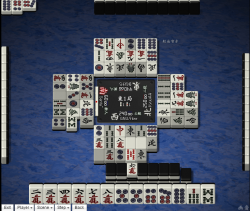Haitei raoyue and houtei raoyui: Difference between revisions
m (→Haiteihai: Update main article link.) |
(→Compatability: Clean up compatibility. The discussion about the legality of calling with the last tiles is out of place; I will put it elsewhere.) |
||
| Line 32: | Line 32: | ||
| HOU || {{yes}} || {{yes}} || {{no}} || {{no}} || {{yes}} || {{yes}} || {{yes}} || {{yes}} || {{yes}} || {{yes}} || {{yes}} || {{yes}} || {{yes}} || {{yes}} || {{yes}} || {{yes}} || {{yes}} || {{yes}} || {{yes}} || {{yes}} || {{yes}} || {{yes}} || {{no}} ||bgcolor="000000"| ||bgcolor="000000"| || {{no}} | | HOU || {{yes}} || {{yes}} || {{no}} || {{no}} || {{yes}} || {{yes}} || {{yes}} || {{yes}} || {{yes}} || {{yes}} || {{yes}} || {{yes}} || {{yes}} || {{yes}} || {{yes}} || {{yes}} || {{yes}} || {{yes}} || {{yes}} || {{yes}} || {{yes}} || {{yes}} || {{no}} ||bgcolor="000000"| ||bgcolor="000000"| || {{no}} | ||
|} | |} | ||
Haitei and houtei are mutually exclusive with each other, with [[chankan]], and with [[rinshan kaihou]], because each of them requires the winning tile to come from a different location (the live wall, a discard, a [[shouminkan]], and the dead wall, respectively). Houtei cannot combine with [[mentsumo]] because it is only winnable via discards. | |||
As for [[ippatsu]], it is impossible for the player calling riichi to have the last discard occur within one turn, because there must be at least 4 tiles left in the live wall when calling riichi. If an intervening call was made, which might mean that the player calling riichi would not get another draw, that call alone would disqualify an ippatsu. It is possible, however, for a player to call riichi with exactly four tiles left in the live wall and subsequently get both ippatsu and haitei on their next draw. | |||
== Setting up haitei raoyue or houtei raoyui== | == Setting up haitei raoyue or houtei raoyui== | ||
Revision as of 19:14, 30 January 2015
| Type | Yaku |
|---|---|
| Kanji |
海底撈月 河底撈魚 |
| English |
Win by last draw Win by last discard |
| Value | 1 han |
| Speed | Very Slow |
| Difficulty | Luck |
Haitei raoyue 「海底撈月」 or simply Haitei is a standard yaku, where a player wins with the tsumo on the haiteihai, the last drawable tile from the live wall. As such, this yaku is only accessible via tsumo.
Houtei raoyui 「河底撈魚」 is the ron variant to haitei, which is dependent on the last discarded tile of a hand. So, players making the last discard of the hand must take extra care not to play into another player's hand in this case.
The last tile draw and discard is defined by the dead wall. By rule, the dead wall must retain 14-tiles at all times; and this includes any revealed dora indicators. Naturally, to score either haitei or houtei, a player must be at tenpai at the end of the hand just before ryuukyoku. Finally, hands may definitely be declared for a win, if either haitei or houtei is the only yaku of the hand.
Haiteihai
Haiteihai 「海底牌」 is the very last tile that can be drawn from the regular wall. This is clearly indicated as the 15th tile left, counting the tiles of the dead wall including the dora indicator. Typically, this tile resides as the lower of two tiles next to the back end of the dead wall. Earlier calls for kan may "alter" the designation of the last tile, as that same bottom tile gets shifted into the dead wall to maintain fourteen tiles after the rinshan draw.
Likewise, the very last discard is called houteihai 「河底牌」, which is subject to the call of "ron" for the houtei raoyui yaku and nothing else. Tile calls of chii, pon, or kan cannot apply to it.
Compatability
^ Ippatsu requires riichi to be of any use.
| RCH | DRI | IPP^ | SMO | TAN | PFU | IPK | ITT | YAK | SDJ | SDO | TOI | SNA | SNK | CHA | JUN | RPK | SSG | HRO | HON | CHN | CHI | RIN | HAI | HOU | CHK | |
| HAI | ||||||||||||||||||||||||||
| HOU |
Haitei and houtei are mutually exclusive with each other, with chankan, and with rinshan kaihou, because each of them requires the winning tile to come from a different location (the live wall, a discard, a shouminkan, and the dead wall, respectively). Houtei cannot combine with mentsumo because it is only winnable via discards.
As for ippatsu, it is impossible for the player calling riichi to have the last discard occur within one turn, because there must be at least 4 tiles left in the live wall when calling riichi. If an intervening call was made, which might mean that the player calling riichi would not get another draw, that call alone would disqualify an ippatsu. It is possible, however, for a player to call riichi with exactly four tiles left in the live wall and subsequently get both ippatsu and haitei on their next draw.
Setting up haitei raoyue or houtei raoyui

Like any hand, either yaku requires tenpai at the very last draw and/or discard to even have a chance of winning.
External links
- Haitei raoyue in Japanese Wikipedia.
- Houtei raoyui in Japanese Wikipedia.
| |||||||||||||||||||||||||||||||
